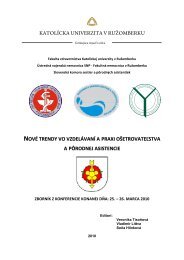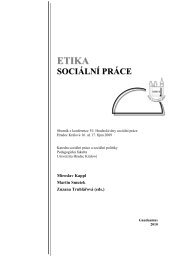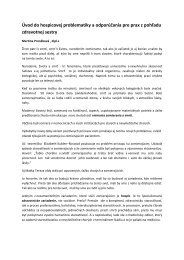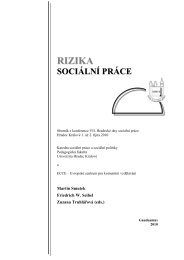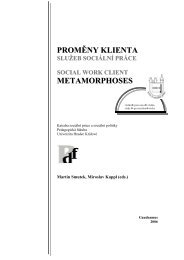Zmena klÃmy â možný dopad (nielen) na obyvateľstvo - Prohuman
Zmena klÃmy â možný dopad (nielen) na obyvateľstvo - Prohuman
Zmena klÃmy â možný dopad (nielen) na obyvateľstvo - Prohuman
Create successful ePaper yourself
Turn your PDF publications into a flip-book with our unique Google optimized e-Paper software.
HIV/AIDS, ENVIRONMENT AND CLIMATE CHANGE –<br />
NEW CHALLENGES AND APPROACH TO THE EPIDEMICS<br />
Jozef Šuvada<br />
Abstract<br />
HIV/AIDS is aggravated by poor environment. AIDS blossoms when opportunistic<br />
diseases set in and immunity breaks down. Poor environment leads to epidemics.<br />
Sanitation and waste ma<strong>na</strong>gement systems are poorly designed and operated;<br />
hence risks to tuberculosis, malaria, and typhoid are multiplied. Malaria cases<br />
were five times those of HIV in 2002. Malaria is reported to have killed more than 10<br />
million people in the past 40 years and yet most parasites are immune to malarial<br />
drugs. There are many infectious agents which spread and input on the HIV-infected<br />
population correlate with environment and with climate change most of<br />
them change the face and could cause danger to the HIV-infected but also general<br />
population. Among the factors and behaviours mentioned by many authors as encouraging<br />
the spread of HIV/AIDS include social environments such as exposure to<br />
globalisation, electronic media that distort local culture and values, gender violence,<br />
conflicts, distorted beliefs and information on HIV/AIDS and STDs.<br />
Key Words: HIV/AIDS, infectious diseases, climate change, environment, resistance,<br />
poverty, development<br />
INTRODUCTION<br />
Identifying possible interrelation between climate and HIV/AIDS might seem at<br />
first glance, far fetched. But is it really so? One might form a different option<br />
after reading this paper. Sceptics might also think that such topic would have no<br />
policy or programmatic relevance. When we centred on the concept of hotspots,<br />
in which climatic factors can play an important role, it begins to be clear that<br />
certain aspects of climate are useful within the framework of an Early Warning<br />
Rapic Response System (firstly described by UNDP in 2004) for HIV/AIDS. Thus,<br />
early warning system for HIV/AIDS can produce synergies with other warning<br />
systems, for example in agriculture and food security, which can also be climate<br />
dependent. There has been published several papers focussing on agriculture and<br />
its importance in HIV/AIDS epidemics, both in itself and in the context of rural<br />
43





